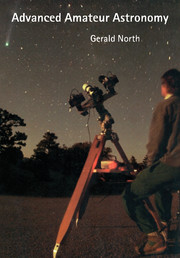Book contents
- Frontmatter
- Contents
- Preface to the second edition
- Preface to the first edition
- Acknowledgements
- 1 Telescope optics
- 2 Atmosphere, seeing, magnification and eyepieces
- 3 Telescope hardware and adjustments
- 4 Astrophotography with the camera
- 5 Astrophotography through the telescope
- 6 Electronic imaging
- 7 The Moon
- 8 The terrestrial planets
- 9 The gas-giant planets
- 10 Asteroids, comets, meteors and aurorae
- 11 The Sun
- 12 Variable stars and novae
- 13 Methods of photometry
- 14 Double stars, star clusters, nebulae, galaxies and supernovae
- 15 Spectroscopy
- 16 Radio astronomy
- 17 Further information
- Appendix: Useful formulae
- Index
- Frontmatter
- Contents
- Preface to the second edition
- Preface to the first edition
- Acknowledgements
- 1 Telescope optics
- 2 Atmosphere, seeing, magnification and eyepieces
- 3 Telescope hardware and adjustments
- 4 Astrophotography with the camera
- 5 Astrophotography through the telescope
- 6 Electronic imaging
- 7 The Moon
- 8 The terrestrial planets
- 9 The gas-giant planets
- 10 Asteroids, comets, meteors and aurorae
- 11 The Sun
- 12 Variable stars and novae
- 13 Methods of photometry
- 14 Double stars, star clusters, nebulae, galaxies and supernovae
- 15 Spectroscopy
- 16 Radio astronomy
- 17 Further information
- Appendix: Useful formulae
- Index
Summary
Currently there are several hundred amateur radio astronomers active over the world. The leading international organisation for coordinating this work is SARA (the Society of Amateur Radio Astronomers). A contact address is: 37, Crater Lake Dr., Coram, N.Y. 11727, U.S.A.
Advances in modern electronics have enabled small radio telescopes to be constructed which are sensitive enough to detect scores of deep-sky objects as well as the much more powerful old favourites: the Sun, meteors, and the Jupiter–Io system. Nonetheless considerable expertise in practical electronics, as well as a good grounding in the theoretical aspects, is necessary to contruct such an instrument and get it working successfully. The final cost is likely to be at least several hundred pounds. Some of the necessary items of equipment can be purchased but the likely cost of a halfway decent radio telescope will then definitely rise to several thousand pounds. Also, this does not include the purchasing of the various items of test equipment, such an oscilloscope (capable of handling u.h.f), a high quality multimeter, an r.f. signal generator, etc.
So, the most likely potential amateur radio astronomer will already be both an electronics ‘buff’ and a radio ham. Consequently I offer just a brief overview of this subject in this chapter and I strongly recommend that anyone interested join SARA and pursue the list of references given in the final chapter of this book.
- Type
- Chapter
- Information
- Advanced Amateur Astronomy , pp. 365 - 378Publisher: Cambridge University PressPrint publication year: 1997



